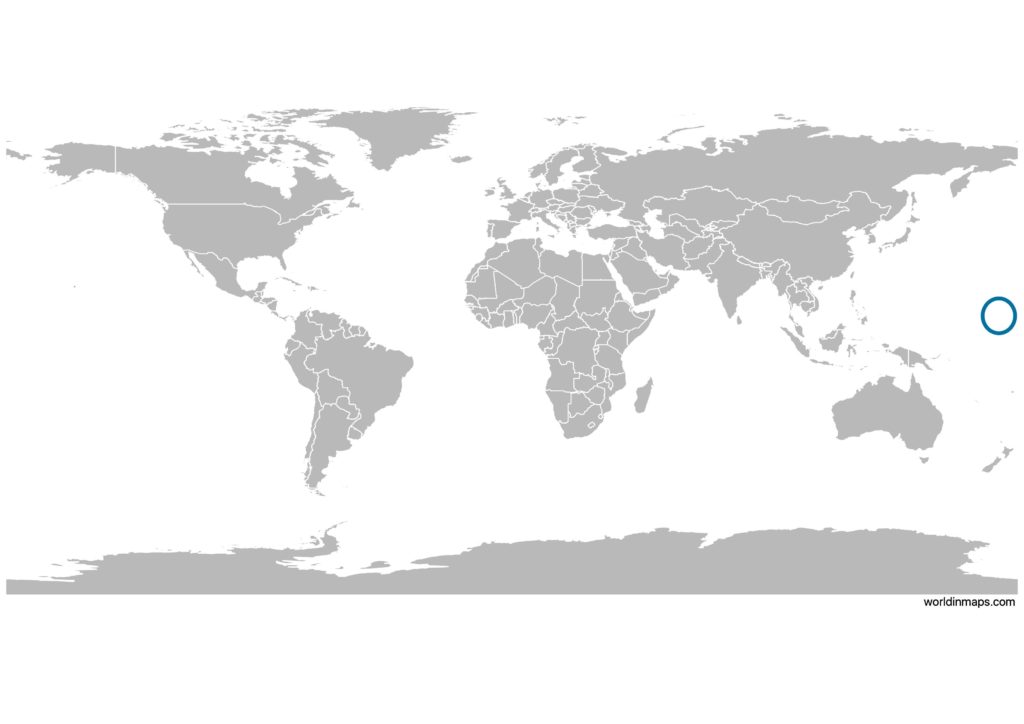Marshall Islands

| Government | |
| Name | Republic of the Marshall Islands |
| Marshallese | Aolepān Aorōkin Ṃajeḷ |
| Government type | mixed presidential-parliamentary system in free association with the US |
| Capital | Majuro (27,797 (2011)) |
| Currency | United States dollar (USD) |
| People | |
| Population (2020) | 59,194 (211th) |
| Density of population | 293.0 P/km2 (28th) |
| Nationality | Marshallese |
| Official languages | |
| Marshallese | |
| English | |
| Ethnic groups (2006) | |
| Marshallese | 92.1% |
| mixed Marshallese | 5.9% |
| other | 2% |
| Religions (2011) | |
| Protestant | 80.5% |
| United Church of Christ | 47% |
| Assembly of God | 16.2% |
| Bukot Nan Jesus | 5.4% |
| Full Gospel | 3.3% |
| Reformed Congressional Church | 3% |
| Salvation Army | 1.9% |
| Seventh Day Adventist | 1.4% |
| Meram in Jesus | 1.2% |
| other Protestant | 1.1% |
| Roman Catholic | 8.5% |
| Mormon | 7% |
| Jehovah’s Witness | 1.7% |
| other | 1.2% |
| none | 1.1% |
| Life expectancy (2020) | |
| Male | 71.8 years |
| Female | 76.5 years |
| Total population | 74.1 years (135th) |
| Homicides | |
| Total (1994) | 4.0 per 100,000 people (74th) |
| Geography | |
| Land area | 181 km2 |
| water area | 0 km2 |
| total area | 181 km2 (217th) |
| Mean elevation | 2 m |
| Lowest point | |
| Pacific Ocean | 0 m |
| Highest point | |
| East-central Airik Island, Maloelap Atoll | 14 m |
| Land use (2011) | |
| Agricultural land | 50.7% |
| Arable land | 7.8% |
| Permanent crops | 31.2% |
| Permanent pasture | 11.7% |
| Forest | 49.3% |
| Other | 0% |
| Urbanization | |
| Urban population (2020) | 77.8% |
| Rate of urbanization | 0.61% annual rate of change (2015 – 2020) |
| Economy | |
| Labor force (2013) | 10,670 (217th) |
| Labor force by occupation (2011) | |
| Agriculture | 11% |
| Industry | 16.3% |
| Services | 72.7% |
| Unemployment rate (2006) | 36% (212th) |
| GDP (PPP) (estimate 2019) | |
| Total | $215 million |
| Per capita | $3,789 |
| GDP (nominal) (estimate 2019) | |
| Total | $220 million |
| Per capita | $3,866 |
| GDP by sector (estimate 2013) | |
| Agriculture | 4.4% |
| Industry | 9.9% |
| Services | 85.7% |
| Exports | NA |
| Exports partners | |
| NA | |
| Imports (2016) | $103.8 million (216th) |
| Imports partners | |
| NA | |
Marshall Islands on the world map

Demography
Age structure data
Estimate for 2020:
- 0-14 years: 32.94% (male 13,090/female 12,575)
- 15-24 years: 19.09% (male 7,568/female 7,308)
- 25-54 years: 37.35% (male 14,834/female 14,270)
- 55-64 years: 5.92% (male 2,269/female 2,341)
- 65 years and over: 4.7% (male 1,805/female 1,857)
Remark: the age structure of a population affects a nation’s key socioeconomic issues. Countries with young populations (high percentage under age 15) need to invest more in schools, while countries with older populations (high percentage ages 65 and over) need to invest more in the health sector. The age structure can also be used to help predict potential political issues. For example, the rapid growth of a young adult population unable to find employment can lead to unrest.
Population from 1950 to 2020
Source: United Nations, Department of Economic and Social Affairs, Population Division (2019). World Population Prospects 2019, Online Edition. Rev. 1.
Economy
Agriculture:
coconuts, tomatoes, melons, taro, breadfruit, fruits, pigs, chickens
Industries:
copra, tuna processing, tourism, craft items (from seashells, wood, and pearls)
Exports – commodities:
copra cake, coconut oil, handicrafts, fish
Imports – commodities:
foodstuffs, machinery and equipment, fuels, beverages, tobacco
Time zone and current time in Marshall Islands
Go to our interactive map to get the current time in Marshall Islands